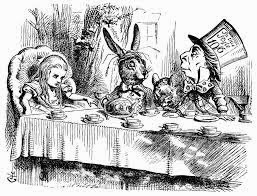 |
| Katniss: what took her so long? |
I wish I was as brave as Katniss
Everdeen, the reluctant protagonist of Suzanne Collins's The Hunger Games trilogy. As a mother of adolescent girls, I welcome
this bow-wielding young adult female role model. Next Friday is our long-awaited
family date for the premiere of the second movie. I have already
ordered the popcorn.
 The significance of the Stoical Katniss,
played with conviction by Jennifer Lawrence, cannot be over-estimated. Quest
she-heroes just did not happen in the western imagination until Alice fell down
the rabbit-hole to Wonderland in Lewis Carroll’s 1865 novel, followed by the
more radical Dorothy in L. Frank Baum’s The Wonderful Wizard of Oz (1900).
The significance of the Stoical Katniss,
played with conviction by Jennifer Lawrence, cannot be over-estimated. Quest
she-heroes just did not happen in the western imagination until Alice fell down
the rabbit-hole to Wonderland in Lewis Carroll’s 1865 novel, followed by the
more radical Dorothy in L. Frank Baum’s The Wonderful Wizard of Oz (1900).
 |
| Dorothy: Quest Hero |
Dorothy explicitly left Kansas
to search for something other than a
man to marry--her totemic pet dog. Baum supported Women’s Suffrage and his mother-in-law Matilda
Joslyn Gage, a prominent feminist. Yet
both Alice and Dorothy were portrayed as pre-adolescent. A biological woman with a
mission that had nothing to do with
catching a man-for-babies took many more decades to appear.
None of this is my idea. It was
in an incendiary 1985 lecture, entitled "What was Penelope unweaving?" that American scholar Carolyn Heilbrun identified the absence
of female quest heroes as preventing women from escaping the single narrative
line in which they have been configured. Heilbrun showed how few narratives prepared
women for entry into public life rather than the marriage market, kitchen or
nursery. She identified Homer’s Penelope—static on Ithaca, bored and
unfulfilled—as the figure who defines, by what she was not allowed to do, the dreadful plotline plight of womankind.
 |
| Iphigenia saves Two Big Strong Men |
The ancient candidates for the
status of female action- / quest-hero are few, but two exist and are both associated
with the archer-goddess Artemis. One is the never-to-be-wed, intelligent and
altruistic Iphigenia who in Euripides’ Iphigenia in Tauris rescues her brother Orestes, his male chum, and the “holy grail” of the cult image of Artemis. The other is
Saint Thecla, who (in by far the most exciting of the apocryphal apostolic Christian Acts)
tames animals in the amphitheatre, heals the sick, and dies a virgin in her
nineties, successfully evading gang-rape.
 |
| Thecla Laughs off the Lions |
Sadly, who now reads that obscure
tragedy by Euripides, or Acts which
never made the New Testament? Perhaps the patriarchal Byzantine monks who
put the finishing touches to the selection of our Classical Curriculum strategically marginalized the Artemisian Iphigenia
and Thecla.
But it is in the company of the
spirits of these ancient she-heroes that I will certainly be getting inspired by Katniss at
Cheltenham Cineworld next Friday.

 The significance of the Stoical Katniss,
played with conviction by Jennifer Lawrence, cannot be over-estimated. Quest
she-heroes just did not happen in the western imagination until Alice fell down
the rabbit-hole to Wonderland in Lewis Carroll’s 1865 novel, followed by the
more radical Dorothy in L. Frank Baum’s The Wonderful Wizard of Oz (1900).
The significance of the Stoical Katniss,
played with conviction by Jennifer Lawrence, cannot be over-estimated. Quest
she-heroes just did not happen in the western imagination until Alice fell down
the rabbit-hole to Wonderland in Lewis Carroll’s 1865 novel, followed by the
more radical Dorothy in L. Frank Baum’s The Wonderful Wizard of Oz (1900). 


Edith rides again. Bravissima!
ReplyDeleteThanks Froma! You are my original Quest Heroine!
ReplyDelete